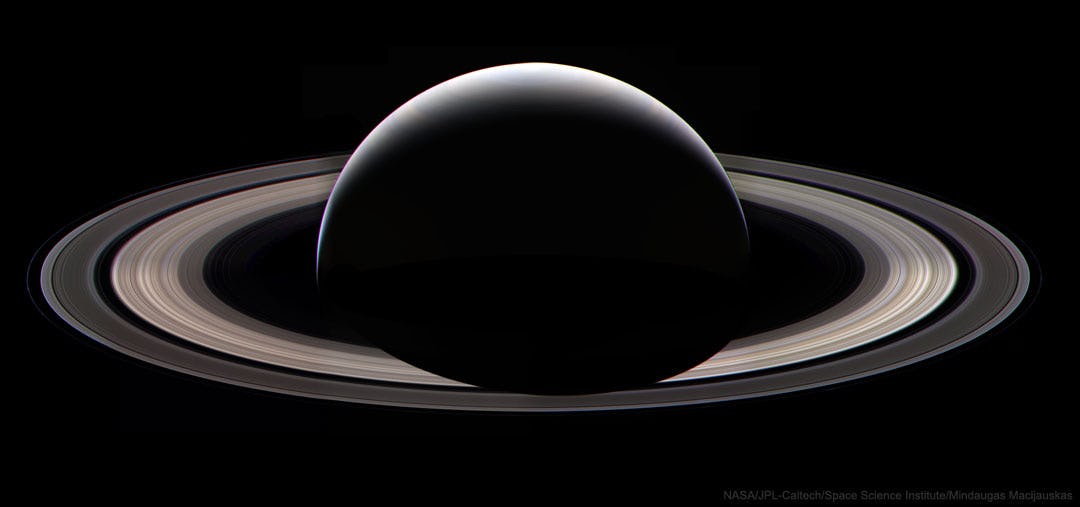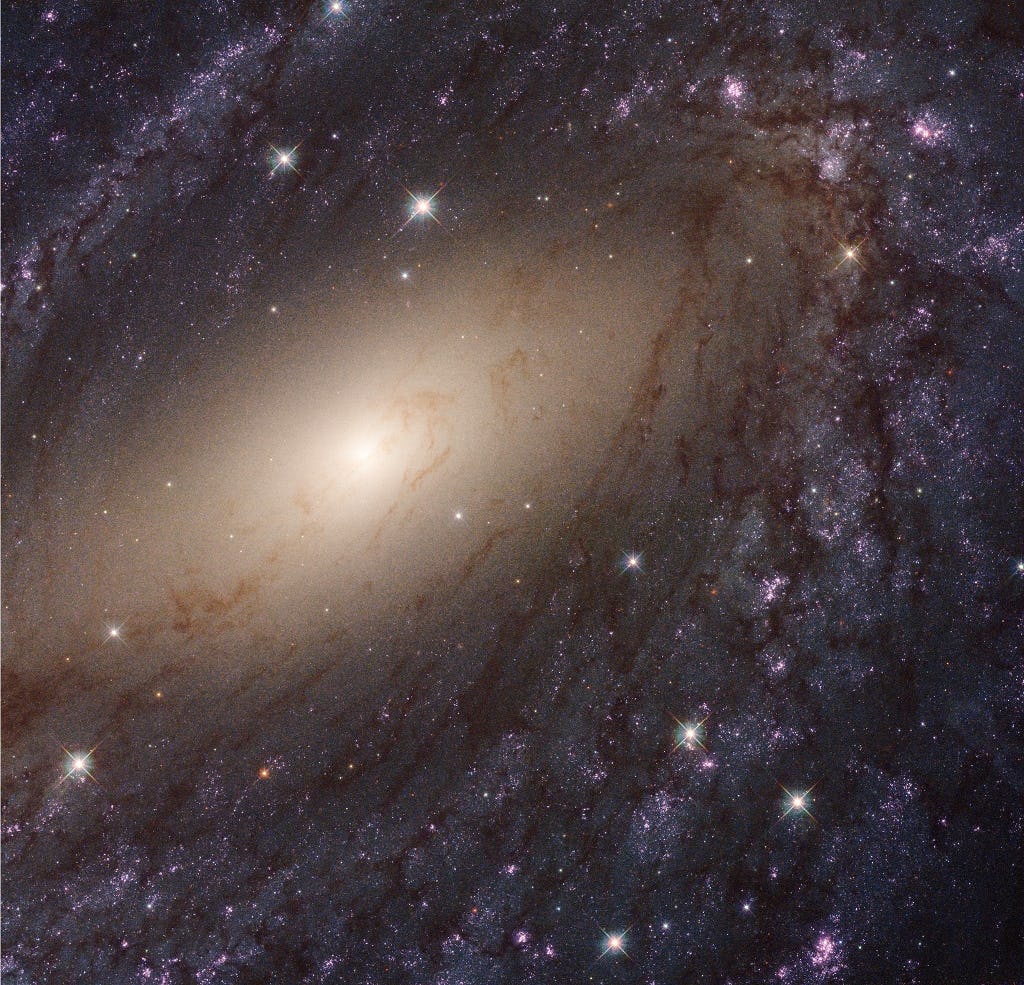Where goeth thou?
Is there a rule,
which can prevent me
from being an old fool?
Public Posts Seattle, WA Seattle, WA (zoom)
Long was the road
to Perdition.
Fraught with perilous hazards
of eternal damnation,
which a sinful person,
passes after death.
Don't be that person.
There is no reason to.
Put forth the kindness
and allow us all.
to see the real you.
Early in the morning,
before the sunrise,
I milked our cow,
separated the milk
from the heavy cream,
using a hand cranked,
milk separator.
Placed it in the refrigerator,
our personal rule.
Ate my breakfast
and headed off to school.
NASA Astronomy Picture of the Day:
Saturn is still bright in planet Earth's night skies. Telescopic views of the distant gas giant and its beautiful rings often make it a star at star parties. But this stunning view of Saturn's rings and night side just isn't possible from telescopes closer to the Sun than the outer planet. They can only bring Saturn's day into view. In fact, this image of Saturn's slender sunlit crescent with night's shadow cast across its broad and complex ring system was captured by the Cassini spacecraft. A robot spacecraft from planet Earth, Cassini called Saturn orbit home for 13 years before it was directed to dive into the atmosphere of the gas giant on September 15, 2017. This magnificent mosaic is composed of frames recorded by Cassini's wide-angle camera only two days before its grand final plunge. Saturn's night will not be seen again until another spaceship from Earth calls.
My beloved left our room.
We were watching football.
Apparently, I fell asleep,
and then she went out the door.
An attendant found her,
wandering the hall,
looking for her husband.
That's me.
She told me, "I was afraid,
as I didn't know where you were."
We were sitting next to each other,
later and I asked why she left.
She said, "I didn't know who you
were." The working of a mind
under attack from Dementia-Alzheimer
is an assault no one should have to
deal with Patient or Care giver.
Where ae you,
sweet Barbara?
Where have you gone?
You were from Chicago,
a long time ago.
You taught in London,
teaching English Composition.
You said your husband was
an artist. You spoke German
when we first met.
I enjoyed our conversations,
at dinner, with my wife.
You were a lovely person,
with a sharp wit. I will never
forget our conversations.
You are gone from the residence
but I will never forget our conversations.
Words,
the most powerful
of each day.
Words can make life easier.
Words can take pain away.
Words can be hurtful,
so be careful what you say.
Be kind to one another,
for you know not what occurs
in another's life or action.
Be a blessing not a curse.
Just got the news that the world population has passed 8 billion of us humans. I remember fondly my sociology classes back in the 60’s where my professors absolutely forbid using The Population Bomb as a footnote or a reference. Paul Ehrlich was no scientist, my educators said, he was a dopey doomsday prophet. I think the world population at the time was maybe 4 billion. A lot of us, seemed like to me. 8 billion, well, I have trouble enough getting to know the neighbors now, sure don’t want many more.
One thing I never hear in the debates concerning global warming and climate change is that maybe, just maybe, there are too many of us. More mouths to feed, more houses to build, more cars to drive, more garbage in the landfills, more need for heating and air conditioning, small stuff like that. Sure, turn the thermostat down, but hey, what if there were 4 billion less of us wanting to stay warm? Oh, I know, we love our kids. We love our dozen grandkids. And we certainly love our 100 great grandkids. Although, to be honest, judging from my old man’s memory at 99 years of age, he couldn’t tell you any of their names. And he has a lot of trouble with his grandkids’s names. Which are only three of them. The fact that us 8 billion are living longer thanks to medical science and improved health care doesn’t really help either.
When I came to the South End, four cars drove off going north of our shack, four cars returned home at night. Better believe we knew our neighbors back then and, unfortunately for them, they knew us. Now it’s a constant parade of commuters and contractors and lawn service crews. I don’t recognize most folks at the local grocery. And with my memory, remembering their names wouldn’t be a likelihood.
So when we’re looking for solutions to overheating the planet, why not look at overpopulating it. You won’t miss an extra grandkid or twenty, all I’m saying.
The Skeeter Daddle Diaries
NASA Astronomy Picture of the Day:
Beautiful spiral galaxy NGC 6744 is nearly 175,000 light-years across. That's larger than the Milky Way. It lies some 30 million light-years distant in the southern constellation Pavo, with its galactic disk tilted towards our line of sight. This Hubble close-up of the nearby island universe spans about 24,000 light-years or so across NGC 6744's central region. The Hubble view combines visible light and ultraviolet image data. The giant galaxy's yellowish core is dominated by the visible light from old, cool stars. Beyond the core are star-forming regions and young star clusters scattered along the inner spiral arms. NGC 6744's young star clusters are bright at ultraviolet wavelengths, shown in blue and magenta hues. Spiky stars scattered around the frame are foreground stars and well within our own Milky Way.
Pickleball is the fastest growing sport in the country. In the past few years, its popularity has exploded. Why? COVID? Perhaps to some extent. Personally, my theory is because it’s easy to learn and requires minimal skill or physical exertion – and if you fall, there are three people who can drive you to the hospital. Read more
Pleasing the weather,
we had yesterday.
A need for more moisture,
as the rain stays away.








.jpg?fit=crop&w=280&h=280&q=93)
















 - Copy.jpg?fit=crop&w=280&h=280&q=93)














